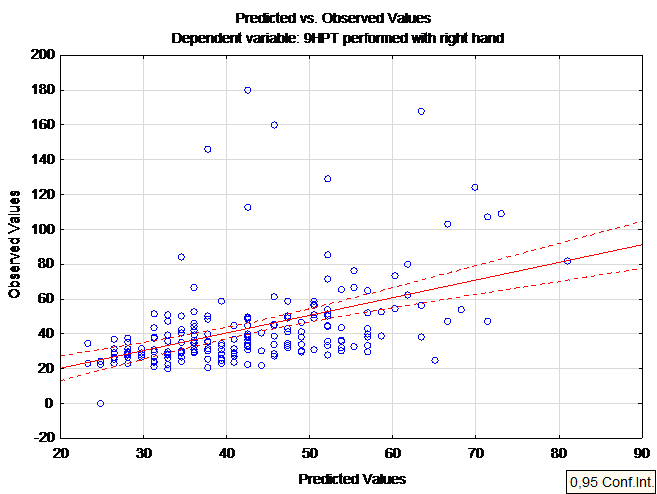Session Information
Date: Sunday, October 7, 2018
Session Title: Other
Session Time: 1:45pm-3:15pm
Location: Hall 3FG
Objective: The purpose of this study was to verify the power of Nine Hole Peg Test (9HPT) and manual strength (MS) to predict the decrease in daily living activities’ independence and in quality of life associated to daily living activities‘ performance.
Background: Although the manual function is affected by the Parkinson’s Disease (PD), there is no a stablished test to evaluate manual function in people with PD. The Nine Hole Peg Test (9HPT) is a fast, simple and cheap test widely used to assess manual function in several neurological conditions. On the other hand, the manual strength (MS) measure by a dynamometer has been used to assess manual function in general populations.
Methods: Participated this study 191 people with Parkinson’s Disease (PD) with 62,10+10,1 mean age, in 1-5 stages of disease evolution according to Hoehn and Yahr (H&Y) Classification (6.10+4.6 years of disease evolution), 38.42+20 mean scores in Unified Parkinson’s Disease Rating Scale (UPDRS), using regular dopaminergic medication. All participants were testes in ON period of medication, in an individual session using section II of UPDRS and section II of Parkinson’s Disease Quality of Life Questionnaire (PDQ-39) to assess the independence in daily living activities, and Nine Hole Peg Test (9HPT) and manual strength (MS) to assess the manual function, performed with both hands.
Results: All participants were able to perform the tests. The results obtained in right and left hands with both manual tests were correlated with severity of motor symptoms, assessed by UPDRS – section III (R> .5, p<.001), and disease evolution, assessed by H&Y classification (R>.4, p<.001) and not correlated with age, gender and disease duration. However, the regression model showed that only the 9HPT performed with right hand was able to predict the scores in UPDRS- section II (R= .47; R²= .22; Adjusted R²= .21; F(1,195)=56.241 p<.00001) and PDQL 39-section II (R= .30 R²= .09; Adjusted R²= .09; F(1.191)=20.21; p<.00001).
Conclusions: The 9HPT performed with dominant hand (right hand) was able to predict the level of independence in daily living activities’ (DLA) and the impact of decline its decline in quality of life in people living with PD. The 9HPT is a cheap, easy and fast test which can be useful do assess the manual function in PD.
References: CHOI, Y. I.; SONG, C.S.; CHUN B.Y. Activities of daily living and manual hand dexterity in persons with idiopathic Parkinson disease. J. Phys. Ther. Sci. Vol. 29, n 3, 2017.
To cite this abstract in AMA style:
C. Dionizio Dias, E. Okamoto, C. Miranda, M. d'Alencar, M.E. Piemonte. Which is the best manual test to predict the daily living activities’ independence in people with Parkinson’s disease? [abstract]. Mov Disord. 2018; 33 (suppl 2). https://www.mdsabstracts.org/abstract/which-is-the-best-manual-test-to-predict-the-daily-living-activities-independence-in-people-with-parkinsons-disease/. Accessed December 17, 2025.« Back to 2018 International Congress
MDS Abstracts - https://www.mdsabstracts.org/abstract/which-is-the-best-manual-test-to-predict-the-daily-living-activities-independence-in-people-with-parkinsons-disease/

